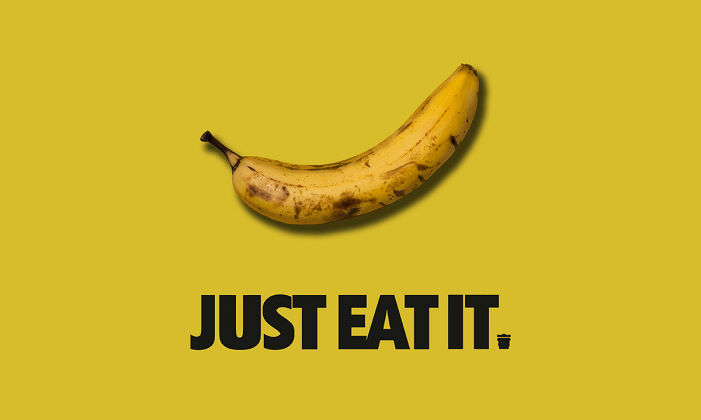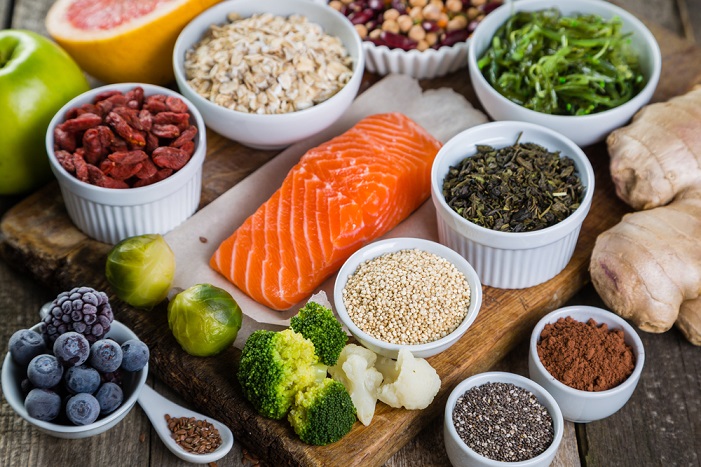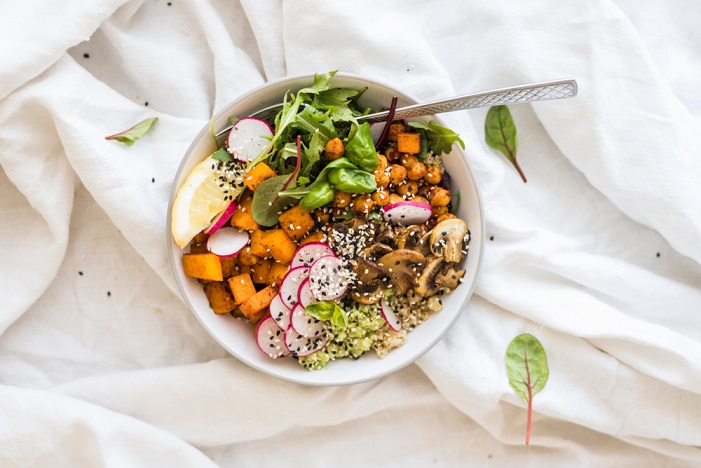Cover image credit @foodwastemovie.com
SUMMARY
Food waste costs you money and strains the planet’s limited resources. Taking a few simple steps to reduce the amount of useable food you waste can help save you money. It may also minimize your impact on the environment.
Food waste is much bigger problem than you might think.
Americans alone waste a massive 150,000 tons of food each day, equivalent to around a pound of food per person or about a third of your daily calorie requirement.
Not only does this food cost you money, it probably ends up on a landfill, producing methane – a potent greenhouse gas – as it decays. It still required water to grow and it was still probably packaged in plastic too.
So whether you look at the issue from the perspective of personal finance, the environment or both, there are plenty of good reasons to take action to combat the issue of waste. But how do you do it? From your habits when you’re picking up groceries to how you store your food and right through to what happens when you do need to throw something away, there are many simple steps you can take to keep your waste to a minimum.
12 Shocking Facts About Food Waste for You and the Planet
6 ways food waste affects you:
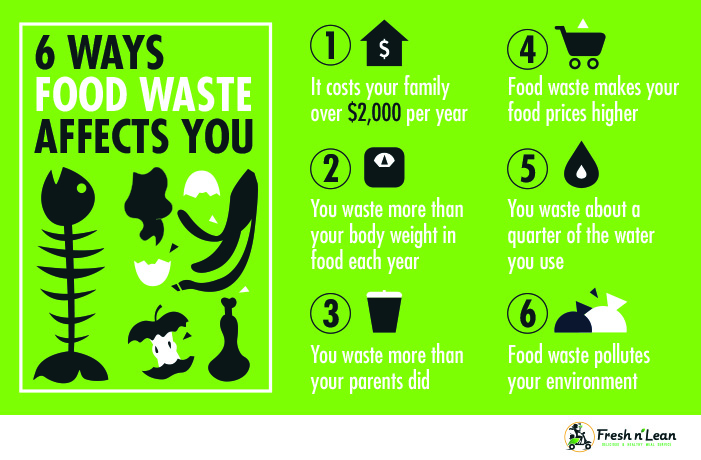
1 – It costs your family over $2,000 per year
Food waste costs the average American family $2,275 every year. Even from a purely selfish perspective, think about what you could do with that money. Would you take a vacation? Go on a shopping spree? Whatever you’d do with the money, you could get much more use out of it than if you threw it in the trash. It might not feel like it, but when you waste food that’s exactly what you’re doing.
2 – You waste more than your body weight in food each year
The average European or North American throws away around 100 kg of food each year, but the average weight is just 70 kg. So you waste more than your whole body weight in food each year.
3 – You waste more your parents did
Food waste in the U.S. has increased by 50 percent since 1974, so it’s almost certain that you waste more food than your parents did. Every pound of food you throw away means wasted packaging, wasted energy, wasted water and wasted money.
4 – Food waste makes your food prices higher
Farmers lose food during harvest and storage, and not only does this reduce their income from the harvest – which is particularly damaging for small farms – the cost also gets passed on to you. This means that food waste makes your weekly shop more expensive than it would be otherwise. The cost of food has increased by 42 percent in the past decade because of food waste. Encouraging stores to stock “ugly” produce – and actually buying misshapen veggies – is one of the best things you can do to minimize this waste.
5 – You waste about a quarter of the water you use
Waste isn’t limited to food. You actually waste around 25 percent of the water your household uses too, through things like leaving the tap on when you brush your teeth. Water isn’t a limitless resource, and again this translates into money you’re just letting wash down the drain.
6 – Food waste pollutes your environment
The environmental impacts of food waste might seem like they don’t personally affect you, but they do. Food rotting on landfills and giving off methane increases the temperature of the planet, but the packaging and other toxic by-products pollutes the water you depend on and the air you breathe. The less we put on landfills, the nicer an environment we will all have to live in.
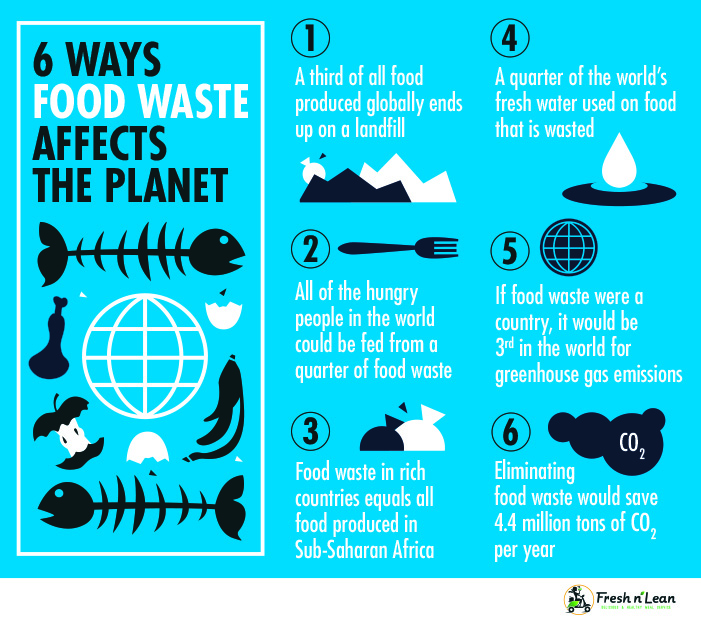
1 – A third of all food produced globally ends up on a landfill
We waste a staggering third of all the food produced. This is a shocking amount that’s really hard to wrap your head around. Next time you drive past a field of crops or livestock, imagine one third of that being harvested and tossed straight into the trash. That is happening all around the world, and all the time.
2 – All of the hungry people in the world could be fed from a quarter of food waste
There are about one billion people on the planet going hungry. This is tragic enough on its own, but it only gets worse when you realize that they could all be fed on just a quarter of food waste from the US and Europe. Others starve while we toss perfectly good food in the trash.
3 – A quarter of the world’s fresh water is used on food that is wasted
Water is a limited resource, but growing food – especially food for livestock – uses up a lot of water. Food waste means a lot of this is completely wasted, though, with a quarter of all of the world’s fresh water being used to grow food that’s just thrown away.
4 – Eliminating food waste would save 4.4 million tons of CO2 per year
Through the production and shipping of wasted food, we emit 4.4 million tons of CO2 every year. This isn’t CO2 that we need to emit, this is for the food that is never even used, and then just goes to a landfill and produces another greenhouse gas as it decays. Eliminating food waste would be the equivalent of taking one in four cars off the road in terms of CO2 alone.
5 – Food waste in rich countries equals all food produced in Sub-Saharan Africa
Rich countries waste around 222 million tons of food each year, but the whole sub-Saharan region of Africa only produces 230 million tons of food per year. That means rich countries like the U.S. waste as much food as the bulk of Africa produces in total.
6 – If food waste were a country, it would be 3rd in the world for greenhouse gas emissions
If all of the food waste in the world were treated as a country’s greenhouse gas emissions, it would be ranked third in the world for greenhouse gas emissions. This would mean that the only two countries that emit more greenhouse gases would be the U.S. and China.
18 Easy Ways to Minimize Food Waste
- Plan your meals in advance and shop accordingly.
- Check what you already have in your kitchen before heading to the store.
- Only buy what you need, picking up loose fruit and veg rather than pre-packaged bags.
- Learn what needs to be stored in the refrigerator and what is better out of the fridge.
- Learn the best locations in the refrigerator to store different items.
- Operate a first in, first out system in your refrigerator.
- Trust your senses, not use-by dates.
- Moderate your portions – check the recommended servings (or use a portion planner) and stick to them.
- Choose smaller plates to encourage smaller portions.
- Save your leftovers.
- Take your leftovers for lunch the next day; don’t just leave them in the refrigerator.
- Have a “use-it-up” meal each week where you use anything that’s at risk of going bad.
- Can or pickle any fruits and vegetables you might not use otherwise.
- Make stocks and smoothies with anything that’s almost off or would otherwise be wasted.
- Keep track of anything you do waste.
- Try to donate any food you won’t use.
- Create a compost heap rather than throwing food in the trash.
- Only throw your food in the trash as a last resort.
Minimizing Food Waste: In-Depth
We’ve provided the key tips in short form above, but some more information on some tips will help you put the advice into practice. The key bits of advice are bolded, and the following text provides more information about what you should do.
Shop Smart
Food waste starts when you go to the store. Decisions you make when you’re browsing and how much thought you put into the process before you head to the store can make a huge difference to how much of the food you buy will end up in the trash.
Plan your meals
The first and most important piece of advice is to plan your meals. Instead of picking up a whole bunch of stuff that it just seems like you’ll use, it makes it much easier to only buy things for an explicit purpose. You don’t just pick up an eggplant because they’re tasty, you pick it up specifically to use in that parmigiana recipe you saw. It also helps you avoid the impulse-purchases that stores try to coax out of you at every opportunity.
It does take time, but it helps you put together a focused shopping list and it makes sure you never have to nip to the store to pick up some last-minute extras.
Don’t double-buy groceries
Next, it’s important to check what you already have in before you go to the store. This is a really simple step, but people (including myself!) frequently double-buy an item because they just assume that they need more rather than actually checking.
You can also make a lot of good decisions when you’re actually picking up things you need from your list. For example, buy loose vegetables rather than larger pre-packaged bags. In most stores, you can get a plastic bag and choose however much of a fruit or vegetable you want by picking some loose. This is generally more affordable, but stores will usually include some of the same thing in fairly large, waste-encouraging bags for those who choose convenience.
SUMMARY
- Plan your meals.
- Check what you already have in before going to the grocery store.
- Buy loose fruits and vegetables rather than larger pre-packaged bags.
Store Sensibly
Once you’ve followed the advice above and got your sensible amount of shopping from the store, the next challenge is minimizing spoilage. This means learning to store all of your fruits and vegetables in the right place, making sure you’re eating the oldest things first and trusting your senses rather than a use-by date.
Store food in the right place
The first tip is to store your food in the correct places. For a start, different fruits and vegetables need to be stored in different places. For example, bananas, tomatoes and peppers are best stored out of the refrigerator, while most fruits and veggies last longer inside it.
Even for the stuff you keep in the refrigerator, you need to take care to put them in the right parts of the refrigerator. There is a guide for what to put in which places in your refrigerator here, but there are some simple rules you can pick up easily.
Your bottom drawers are ideal for fruits and vegetables (as well as herbs and anything vacuum sealed), the bottom shelf is great for leftover meats, berries and hard veg, the middle is best for fish, deli meats, cheese and anything that says “refrigerate after opening,” and the top shelf is great for milk, fruit juices and anything that you want to be cold but not too cold. Look at the link above (or the large image here) for more information.
“Use-by” dates aren’t always reliable
Arguably the most important piece of advice when it comes to storage is that “use by” dates aren’t usually reliable when it comes to whether you can still eat something. If you store your food properly, chances are, most items will last at least a couple of days past their recommended use by date. The best advice is to examine and smell the food, and if it seems OK (and if it’s possible before cooking) taste it to check. Trust your senses rather than the use by date and you’ll end up using up a lot of things you’d normally toss into the trash.
SUMMARY
- Store your food in the correct places.
- “Use by” dates aren’t usually reliable and most foods can last a few days past their recommended use by date if stored properly.
Cook Carefully
Now you’ve bought a reasonable selection and amount of food and have it all stored sensibly, the next stage where you can lose perfectly good food is during cooking. This is quite easy to do, provided you don’t over-do your portions and make the effort to use up any leftovers.
Measure your portions
Firstly, and most importantly, moderate your portions and don’t throw away leftovers. Take some time before cooking to measure out your portions carefully, and you’re much less likely to be put in this situation. Even with affordable staple foods like rice or pasta, measuring portions –rather than just adding some extra to be sure you get enough – can save you a lot of waste.
Of course, you’ll still have leftovers sometimes, but you can save these and you won’t have as much. Make sure you eat your leftovers too – taking them to work the next day for lunch is an easy solution to this issue.
Make a “use it up” meal
Get through any extra food in your refrigerator or pantry by having a “use it up” meal regularly. For example, you might have picked up a squash for a meal that you never had time to make, and you’ll probably have some odd bits of vegetables leftover no matter how careful you were when it came to doing your shopping.
But with a squash and some other leftover veggies, you can easily put together a delicious vegetable soup or bulk out a stew or casserole.
Canning or pickling fruits and vegetables
If you have a lot of fresh produce at risk of going bad, consider canning or pickling fruits and vegetables. This is a little bit of work – for example, pickling involves creating a salt or vinegar brine in many cases – but it will preserve your fresh produce for much longer than storage alone would. There are guides to pickling and canning that will lead you through the process, and it’s well worth it if you always end up with a lot of food going to waste.
Make stocks and smoothies
Finally, you can make stocks and smoothies with any fruits and vegetables that you won’t use otherwise. You can make smoothies really easily if you have a blender or a juicer, and you can pretty much incorporate any fruits you have into a delicious smoothie. Stock is ideal for almost-off veggies, and you can even use any bones from meats or inedible parts to make a stock too.
SUMMARY
- Moderate your portions and don’t throw away leftovers.
- Get through any extra food in your refrigerator by having a “use it up” meal regularly.
- Consider canning or pickling fruits and vegetables that are at risk of going bad.
- Make stocks and smoothies with any fruits and vegetables that you won’t use otherwise.
If All Else Fails…
Despite your best efforts, you will sometimes have waste. If you can avoid all waste, that’s fantastic, but realistically speaking it’s pretty difficult to accomplish. So what do you do to minimize the impact?
Keep track of your wastage. Simply noting down how much food you throw away keeps the amount you’re wasting fresh in your mind, and will encourage you to be more careful about what you buy and how you cook in future.
Donate first, then compost, then trash
When throwing food away, try to donate first, if you can’t, then compost it, and if you can’t do that, throw it in the trash. Keeping this order in mind minimizes the amount of food that ends up on a landfill. Donating food is best because then it will actually get eaten. Composting isn’t perfect – it will still produce methane as it rots, for instance – but at least you’ll get some usable compost at the end of the process. Only if you can’t do either of those should you toss some food into the trash.
SUMMARY
- Keep track of your wastage.
- When throwing food away, try to donate first. If you can’t, then compost it, and if you can’t do that, throw it in the trash.
What Types of Food Are Wasted the Most?
Food waste isn’t equally split across the different foods that we eat: some types of food are wasted more than others. If you look at the most wasted foods, you’ll consistently see that fruits and vegetables are wasted more than other types of food. For fruit, a 2018 study found that fruits and vegetables accounted for almost 39 percent of the average daily food waste in the U.S., which is substantially more than any other food category.
Dairy is the next-most wasted type of food, but this only accounts for 17 percent of food waste for the average American. Meat and meat dishes account for 13.5 percent of food waste, and grains account for around 12 percent.
Other types of food were responsible for much less food waste, with the next biggest category including mainly candy, soft drinks and beverages, and accounting for almost 6 percent of food waste.
The picture painted by this data is pretty easy to understand: it’s the healthiest foods we’re most likely to waste. The main take-away from this study is that you should think especially carefully about the amount of fruits and vegetables you buy when you go to the store, because that’s where most of your wasted money comes from.
Countries with the Highest Food Waste
Across the world, the amount of food wasted varies country-by-country, but it shouldn’t come as much of a surprise that the richest countries are among the worst. The most wasteful country per person is Australia, wasting about 361 kg of food per person per year, but the U.S. isn’t far behind, with a waste of 287 kg per person per year. At the other end of the scale, Greece and China both only waste 44 kg of food per person per year, and India isn’t much worse than them with just 51 kg of food wasted per person per year.
If you just look at the total amount of food wasted, though – and don’t take into account the population size – the U.S. wastes more food per year than any country. For the whole country per year, almost 91 billion kilograms of food are wasted. China and India are both much more heavily-populated than the U.S., but they waste less overall, at 61 and 68 billion kilograms wasted each year, respectively.
Unfortunately, the U.S. doesn’t come off well with either method of comparison.
Food Waste Trends in the U.S.
A 2009 study looked at food waste in the U.S. since 1974 and investigated its environmental impact, and the news wasn’t good. The research showed that the amount of food waste in the U.S. increased by approximately 50 percent between 1974 and 2003, going up from an average of 900 calories (kcal) per day to a massive 1,400 calories per day, per person. This is a huge amount of food, accounting for roughly two-thirds of your recommended daily calorie intake.
In addition, in terms of energy, it takes about 3 calories to produce 1 calorie of food, which means that in 2003, food waste accounted for about 4 percent of total U.S. oil consumption, or about 300 million barrels of oil per year.
Although the 2009 study is one of the latest to look at food waste trends over the long term for the whole U.S., state-level research suggests that things aren’t getting better. In Iowa, for example, it was found that food waste increased by 50 percent between 2011 and 2017, based on the contents of landfills in the state. They found that a fifth of all of the waste in the landfill was food waste.
In a nutshell, the problem was already bad and it’s actually getting worse.
Reducing Food Waste Over the Holiday Season
Thanksgiving and Christmas dinners are often celebrations of excess. The host – understandably – wants to make sure there’s enough food for all of his or her guests, and there is always a temptation to put on a full-blown feast for your family. However, when it comes to food waste, the result of this is often even more food on the landfill. In addition to the tips above for reducing your food waste in general, there are also a few tips specifically for the holidays that can really help you cut down on overall waste.
- Encourage self-serving. Even if there is too much food, it’s easier to save and re-use if it hasn’t been split off into plates for each guest.
- Plan your portion sizes. I know it seems a bit of a miserly thing to do over the holidays, but using a portion planner and basing the total amounts of each component on that can really help to reduce waste.
- Drop the dishes people don’t like. Many people hate sprouts, for example, and while they may be a traditional addition in your household, re-thinking serving them at all – as well as other often-maligned dishes – can really help you reduce your waste.
- Make sure you have a good way to use leftovers. Love Food, Hate Waste has a top five list of things you can do with the most common holiday leftovers.
Wave Goodbye to Waste
There are many tips you can use to reduce your food waste, but the important thing is to make a conscious effort to avoid waste. When you start to think about waste and stay mindful of any waste you create, it’s easy to come up with solutions like these on your own, and it will help you find the motivation to put the extra effort in to avoid waste.
If the thought of pre-planning meals, perfectly-portioning everything and pickling when needed seems like too much work, there are other solutions – like meal delivery services – and if you care about reducing the impact of waste on the planet (not to mention your wallet), you’ll easily be able to find one that works for you.
Fresh N Lean is the nation’s largest organic meal delivery service. Our tasty, chef-prepared cuisine is always fresh and never frozen, and we offer convenient meal plans like Protein+, Keto, Paleo, Standard Vegan and Mediterranean. Choose Fresh N Lean for affordable nutrition, delivered to your doorstep.
